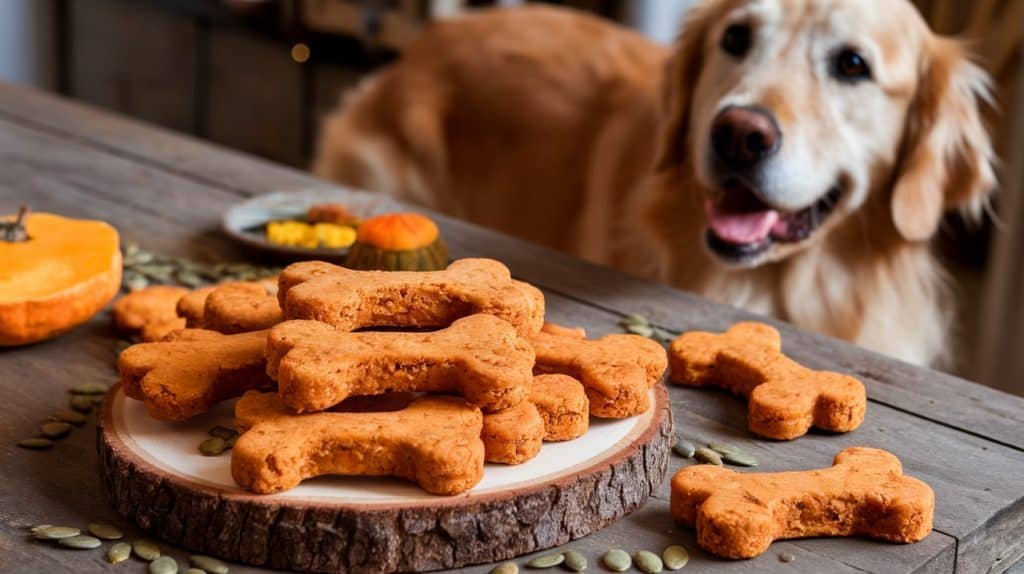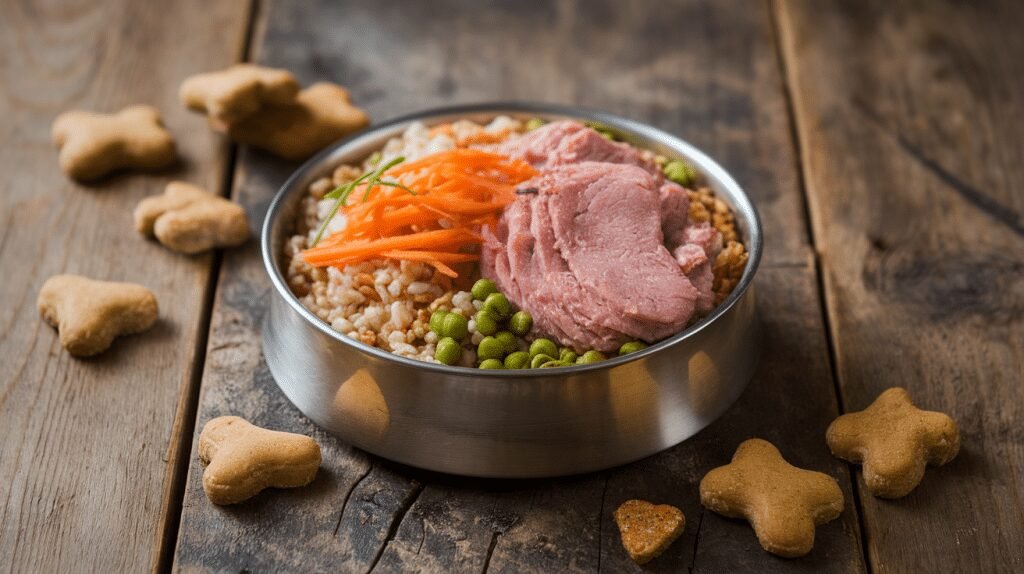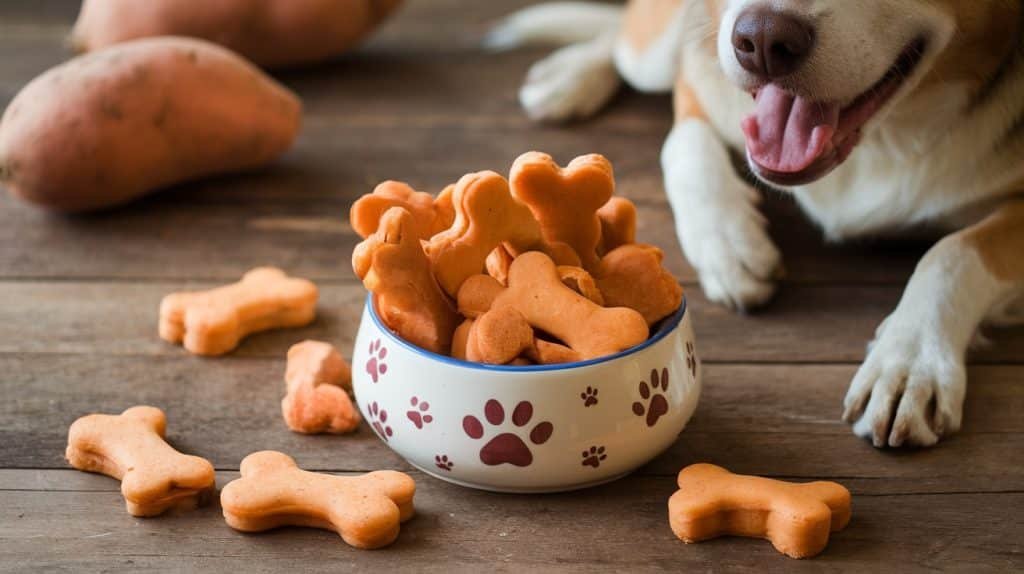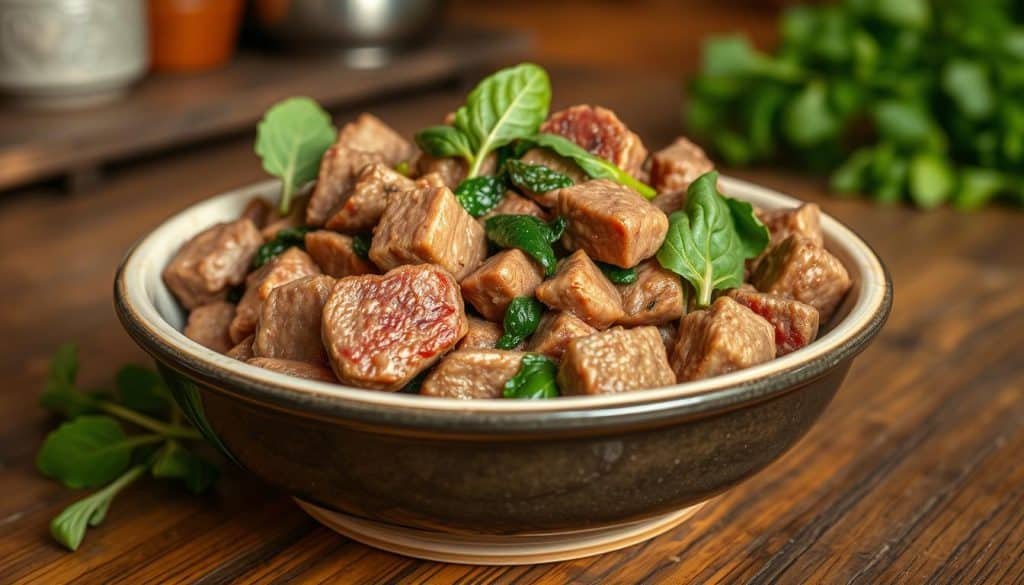
As a dog owner, I’ve always wanted the best for my furry friend. I noticed my dog’s energy dropping and his coat losing its shine. This led me to explore homemade vegetarian dog food.
Creating a meal with fresh ingredients was exciting. It was a chance to improve my dog’s nutrition and energy. Plus, it became a fun way to bond in the kitchen.
With more dog owners choosing vegetarian options, I wanted to share my experience. Here’s a recipe that’s good for your dog’s health and taste buds.
Why I Choose a Vegetarian Diet for My Dog
I chose a vegetarian diet for my dog because I care about animal welfare. Pet food production can be cruel. So, I looked for kinder options that still keep my dog healthy.
Thinking about the planet also influenced my choice. Plant-based dog food is better for the environment than meat. It helps reduce our carbon footprint.
Studies show dogs can do well on a vegetarian diet. They get all the nutrients they need from plants. This can lead to lower cholesterol, better weight, and less risk of diseases like cancer.
Dogs are naturally omnivores. They can easily adjust to eating plants. I pick the right foods to make sure my dog stays healthy and happy.
Benefits of Homemade Dog Food
Preparing homemade dog food has many benefits for dogs and their owners. One key advantage is controlling what goes into the food. Commercial dog food often has additives and preservatives that aren’t good for dogs. Making food at home means I can use natural, healthy ingredients without fillers.
Customizing meals is another big plus. Every dog is different, with their own health needs and tastes. Homemade meals let me adjust the food to fit my dog’s specific needs, ensuring a balanced diet.
Homemade food is also more affordable. Many commercial dog foods are pricey, yet may not be as good quality. Making food at home saves money and lets me know exactly what my dog eats.
Homemade food has made a big difference in my dog’s health. Their energy is up, and their coat looks better than ever. Studies show homemade diets can make pets more lively and happy. Switching to homemade food has made my dog happier and healthier.
| Benefits of Homemade Dog Food | Commercial Dog Food |
|---|---|
| Control over ingredients | Often contains additives and preservatives |
| Customization for health needs | Standardized formulas may not suit all dogs |
| Cost-effective in the long run | Can be expensive for premium brands |
| Improvement in dog’s well-being | Varying results based on breed and diet |
| Fresh and nutritious meals | Packed with shelf-stable ingredients |
Vegetarian Veggie Mix Dog Food Recipe
Making a healthy vegetarian dog diet needs careful picking of ingredients. This veggie mix is not only yummy but also full of health benefits for dogs. Here are the key ingredients I use to make a week’s food for my dog.
Ingredients You’ll Need
- 2 cups of brown rice
- 1 cup of lentils
- 2 cups of diced carrots
- 1 cup of mashed sweet potatoes
- 1 cup of peas
- 2 cups of chopped spinach
- 1/4 cup of flaxseed oil
Nutritional Benefits of Each Ingredient
Each ingredient has a special role in a balanced diet. Let’s dive into their health benefits for dogs:
| Ingredient | Nutritional Benefits |
|---|---|
| Brown Rice | Provides energy and is highly digestible. |
| Lentils | Excellent source of protein and high in fiber. |
| Carrots | Supports good vision and immune function. |
| Sweet Potatoes | Rich in vitamins A and C. |
| Peas | Offers essential minerals and vitamins. |
| Spinach | Contains iron and antioxidants. |
| Flaxseed Oil | Provides omega-3 fatty acids for a healthy coat and skin. |
By mixing these ingredients, we get a balanced meal that keeps my dog healthy. The health benefits of these ingredients make sure my dog gets the nutrition they need.
Preparation Steps for the Veggie Mix
Preparing dog food at home can seem daunting, but it’s actually quite simple. I start by washing all the vegetables well. Clean ingredients are key for safe homemade dog food.
Then, I chop the veggies into small pieces. This makes sure my dog can digest them easily. Next, I soak lentils in water for about an hour. This softens them and boosts digestibility.
While the lentils soak, I prepare the rice. I rinse it and put it in a pot with the right amount of water. Measuring ingredients accurately is vital for balanced nutrition. I check the recipe to get the right mix of veggies, lentils, and rice.
Efficient chopping and pre-soaking the lentils help keep the veggies’ nutrients intact. This makes cooking easier and ensures a healthy meal for my dog.

Cooking Instructions for Perfect Dog Food
Making homemade dog food is easy and rewarding. I’ll show you how to cook a tasty vegetarian mix for your dog. Follow these steps for a healthy meal that keeps your dog happy and healthy.
Step-by-Step Cooking Guide
- Begin by boiling water in a big pot. Use 4 cups of water to cook the lentils and rice.
- When the water boils, add 1 cup of lentils and 1 cup of rice. Stir and lower the heat to low. Let it simmer for 20-25 minutes.
- While the lentils and rice cook, chop carrots, green beans, and peas. Cut them into small pieces. Use about 2 cups total.
- Steam or lightly boil the vegetables for 5-7 minutes. This keeps their nutrients intact.
- After the lentils and rice are done, let them cool for a few minutes.
- In a big bowl, mix the cooked lentils, rice, and steamed vegetables. Make sure they’re well combined.
- If you want, use a food processor to chop the mix. This makes it easier for your dog to eat.
- Keep leftovers in an airtight container in the fridge for up to three days. These simple steps make cooking for your dog a breeze!
Storage Tips for Homemade Dog Food
Keeping dog food fresh is key. I use airtight containers for homemade dog food to keep air and contaminants out. These containers are great for both the fridge and freezer, keeping the food fresh and tasty for my dog.
For quick storage, the fridge is perfect for up to a week. For longer storage, I freeze it in smaller portions. This way, my dog always has healthy meals ready. Remember to label each container with the date to keep track of how long it’s been stored.
When it’s time to eat, I gently reheat the food. A few seconds in the microwave or on the stove works well. Always check the food is warm but not hot before serving. This ensures my dog gets a safe and tasty meal every time.








